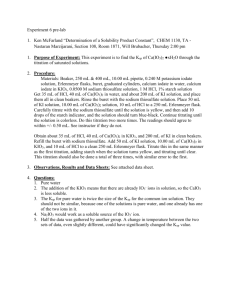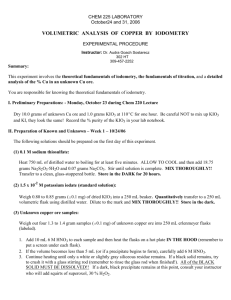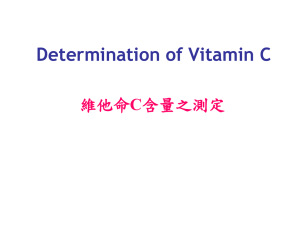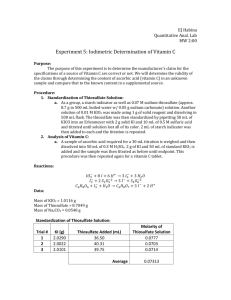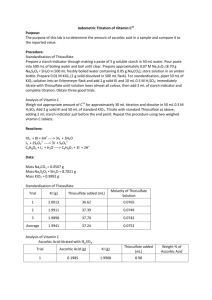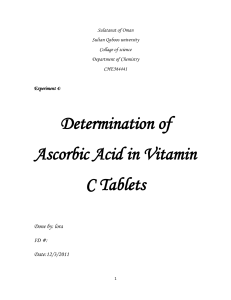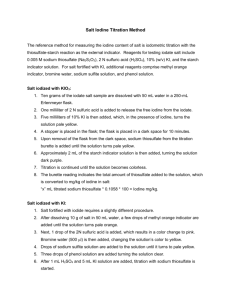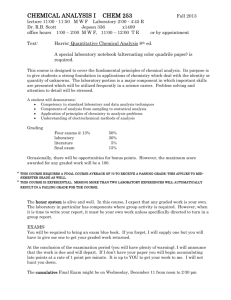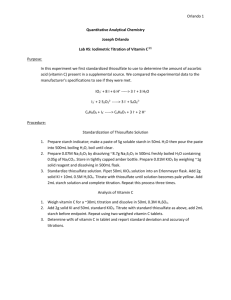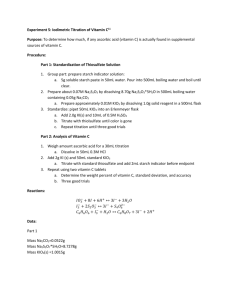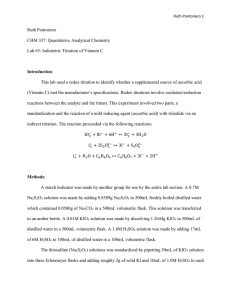3-Determination of Ascorbic Acid in Vitamin C
advertisement
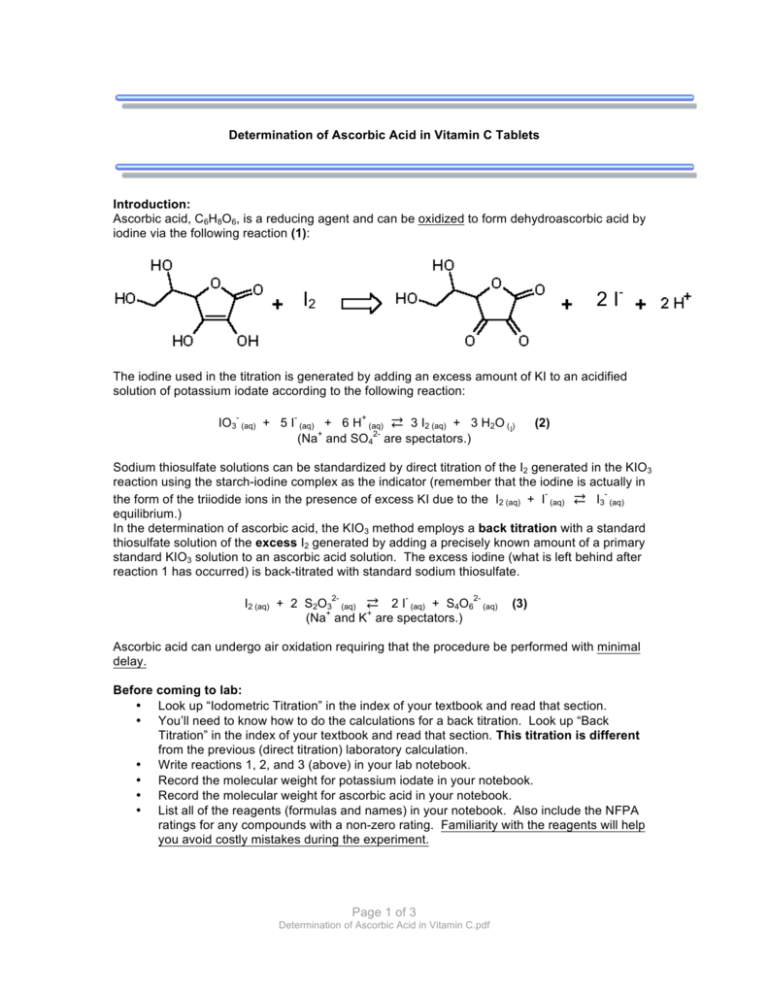
Determination of Ascorbic Acid in Vitamin C Tablets Introduction: Ascorbic acid, C6H8O6, is a reducing agent and can be oxidized to form dehydroascorbic acid by iodine via the following reaction (1): 2 I- I2 The iodine used in the titration is generated by adding an excess amount of KI to an acidified solution of potassium iodate according to the following reaction: IO3 - (aq) + 5I - + 6 H (aq) ⇄ 3 I2 (aq) + 3 H2O (l) + 2(Na and SO4 are spectators.) + (aq) (2) Sodium thiosulfate solutions can be standardized by direct titration of the I2 generated in the KIO3 reaction using the starch-iodine complex as the indicator (remember that the iodine is actually in the form of the triiodide ions in the presence of excess KI due to the I2 (aq) + I (aq) ⇄ I3 (aq) equilibrium.) In the determination of ascorbic acid, the KIO3 method employs a back titration with a standard thiosulfate solution of the excess I2 generated by adding a precisely known amount of a primary standard KIO3 solution to an ascorbic acid solution. The excess iodine (what is left behind after reaction 1 has occurred) is back-titrated with standard sodium thiosulfate. I2 (aq) + 2 S2O3 (aq) ⇄ 2 I (aq) + S4O6 + + (Na and K are spectators.) 2- - 2- (aq) (3) Ascorbic acid can undergo air oxidation requiring that the procedure be performed with minimal delay. Before coming to lab: • Look up “Iodometric Titration” in the index of your textbook and read that section. • You’ll need to know how to do the calculations for a back titration. Look up “Back Titration” in the index of your textbook and read that section. This titration is different from the previous (direct titration) laboratory calculation. • Write reactions 1, 2, and 3 (above) in your lab notebook. • Record the molecular weight for potassium iodate in your notebook. • Record the molecular weight for ascorbic acid in your notebook. • List all of the reagents (formulas and names) in your notebook. Also include the NFPA ratings for any compounds with a non-zero rating. Familiarity with the reagents will help you avoid costly mistakes during the experiment. Page 1 of 3 Determination of Ascorbic Acid in Vitamin C.pdf Reagents: • Potassium iodide • Potassium iodate (be sure to label this bottle) • 0.5 M H2SO4 (be sure to label this bottle) • starch solution Safety Considerations • Look up the MSDS and make a note in your lab notebook of the firefighting measures and storage requirements for potassium iodate. • Look up the MSDS and make a note in your lab notebook any special remarks on reactivity or corrosive nature of potassium iodide, potassium iodate, and sulfuric acid. • Sketch the NFPA diamond for each of the compounds listed above in your lab notebook. Waste Disposal: All solutions in today’s lab can be disposed of down the sink with running water. Experimental Procedure Preparation of a 0.1 M Sodium Thiosulfate Solution: Make this solution in your 1 L plastic bottle and label it with tape. Dissolve about 25 g of sodium thiosulfate pentahydrate crystals in 1 liter of distilled water. Add about 0.2 g of sodium carbonate as a preservative. Shake to ensure complete dissolution and mixing. Preparation of Standard 0.010 M Potassium Iodate: Weigh approximately 2.1 g (to the nearest 0.1 mg) of dried and cooled reagent grade KIO3. Transfer quantitatively to a 1000.0 mL volumetric flask. Initially, dissolve the KIO3 in about 200 mL of distilled water. Dilute to the mark and mix thoroughly. Calculate the concentration of the KIO3 solution. Standardization of 0.10 M sodium thiosulfate (not necessary if you standardized your solution last week and achieved good results) 1. Pipette 50.00 mL of the KIO3 solution into a 250 mL Erlenmeyer flask. 2. Add 2 g of solid KI and 10 mL of 0.5 M H2SO4. 3. Immediately titrate with the thiosulfate solution until the solution has lost its initial reddishbrown color and has become pale yellow. 4. Add 2 mL of starch indicator and complete the titration. 5. Repeat the titration twice or until the concentration of the thiosulfate agrees to within ±1%. Determination of Ascorbic Acid in Vitamin C tablets (at least three replicates) 6. Record your unknown number. Record the number of tablets and the total weight of the tablets to the nearest 0.1 mg before grinding the sample. 7. Grind all of the tablets thoroughly using a clean mortar and pestle. Transfer the ground powder to a clean, dry weighing bottle. 8. Prepare three flasks in the following way. Weigh (to the nearest 0.1 mg) a 0.25 g sample into a 250 mL Erlenmeyer flask. Dissolve sample in 20 mL of 0.5 M H2SO4. Some solid binding material in the tablet formulations may not dissolve completely. At this point, you should prepare and titrate your samples one at a time. Page 2 of 3 Determination of Ascorbic Acid in Vitamin C.pdf 9. Add approximately 3 g KI and exactly 75.00 mL of standard KIO3 to each sample. 10. Immediately titrate with thiosulfate until the solution has lost its initial reddish-brown color and has become pale yellow although it may be difficult to see these colors with other components of the tablets. When in doubt, add the starch early in the titration. 11. Add 2 mL of starch indicator and complete the titration. If starch binder has been used to manufacture the tablets, the characteristic blue color of the starch-iodine complex will appear upon the addition of KI. Because this is a back titration, the I2 that reacted with the ascorbic acid is actually the difference between the moles of I2 generated from the KIO3 and the moles of I2 titrated with sodium thiosulfate, such that: I2 reacting with ascorbic acid = I2 generated - I2 titrated Calculate the % ascorbic acid in your unknown at this point. Report the result in terms of the percentage of ascorbic acid in your unknown. The range of unknown values should be 70% to 100%. SAVE YOUR STANDARDIZED THIOSULFATE SOLUTION FOR THE NEXT EXPERIMENT Last revised 7/7/13 Page 3 of 3 Determination of Ascorbic Acid in Vitamin C.pdf
